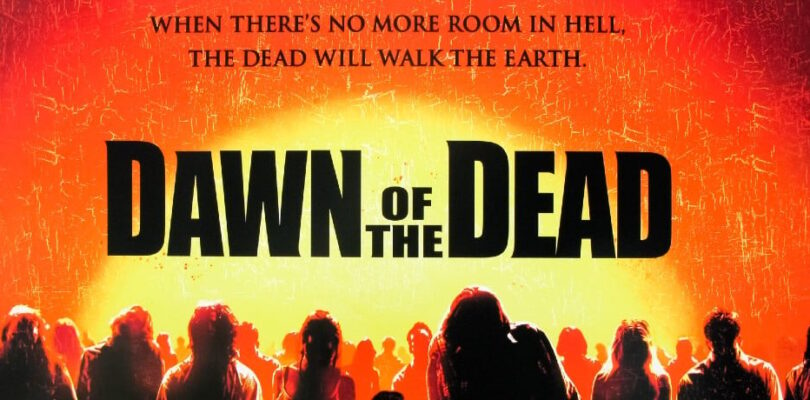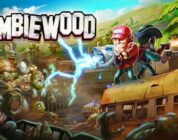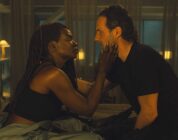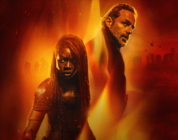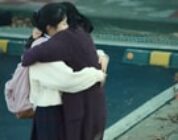Twenty years ago, I saw a movie that changed my life. I also saw Jersey Girl. Not a bad movie. I enjoy it to this day – especially George Carlin as the gruff but loveable grandfather. It’s a fun movie and I recommend you check it out if you haven’t – it really got a bad rap. But that’s not what we’re here to talk about. We’re here to celebrate Zack Snyder’s 2004 remake of Dawn of the Dead.
In March of 2004, some friends and I decided to do a double feature of Jersey Girl (because we liked Kevin Smith) and Dawn of the Dead (because it looked scary). Jersey Girl worked out fine and we all had a nice time, and then Dawn of the Dead had us talking excitedly for the rest of the night. It had an immediate effect, giving us the kind of scares that get you charged up and excited. Zombies weren’t as ubiquitous as they are today, so it felt like something new, even though it was a remake (and none of us had seen the original yet, so it was even newer to us).
Written by James Gunn and directed by Snyder, who would both go on to have incredibly successful careers, Dawn of the Dead was a welcome and exciting shot in the arm for early 2000s horror. 2003 had seen the US release of Danny Boyle’s 28 Day Later, so the idea of a fast-moving zombie wasn’t brand new, but it was still novel. The living dead weren’t the stumbling, bumbling monsters that we had grown up with in cartoons. This was something different, and it felt really dangerous. Zombies for a new era, bringing with them a new kind of fear.
Dawn of the Dead has hooks you from the beginning. Anna (Sarah Polley) is at the end of a long nursing shift at the hospital. One of her patients was admitted earlier that day due to a bite that he had received during a drunken bar fight. Hours later, he is in the ICU, awaiting test results. As Anna finally leaves the building, she sees a team of paramedics pull away in their ambulance. As they drive off, we hear one of them say “It’s starting early,” indicating that not only do they have a long night ahead, but they anticipate it to be an active one as well. In Anna’s car and home, we hear short short sound bites on the radio and TV, referring briefly to a developing emergency situation. We never really get time to zero in before the channel is changed or our attention is pulled elsewhere. Beat by beat, the audience is given just enough to know that something big is about to happen, while the characters remain blissfully unaware.
Until the next morning, that is, when the young neighbor girl shows up in Anna’s bedroom and attacks her husband, biting a huge hole in his neck. He quickly succumbs to his wounds, and is dead for a few moments before returning to life and attacking Anna. She is barely able to escape to her car. As she drives away, we see that her previously typical (dare I say, even boring) middle class neighborhood has become a warzone overnight. People are attacking each other on perfectly manicured lawns. The air is thick with smoke. Emergency vehicles wiz by, and some of the homes are even burning. Whatever has happened, is big.
It’s a fantastic opening sequence, which then leads into one of the greatest opening credits sequences ever. We see a montage of zombie footage, news footage, and footage pulled from real life events and disasters to set the mood for a world on the brink of collapse, all set to Johnny Cash’s “The Man Comes Around.” By the time the intro credits have rolled, the film has established the stakes. The world of the film has gone from familiar to alien in the span of a few short hours as the world tries to get a grip on a global disaster that they can’t understand.
Anna travels through the increasingly unsafe city and soon falls in with a group of people planning to seek shelter at the local mall. They break in and cautiously begin to look around, of course taking out a few violent corpses in the process. Almost immediately, they run into the mall security team. There is an initial power struggle between the security officers (AKA The Guys With Guns) and Everyone Else. After the two more problematic men are disarmed and put into a holding cell, the group can finally begin to work together to do more than argue and make dominance plays. This hit a certain way in the post 9/11 era of its release, and still works well today. We have a small group that has given themselves power and authority because they happen to be armed, and have no interest in joining a larger group and contributing equally to that group’s chances of survival. Eventually, they become more amenable and the leader CJ (Michael Kelly) winds up being one of the strongest characters in the movie, learning to not just think about himself and eventually even sacrificing himself via gas explosion in order to keep the surviving members of the group safe.
The rest of our group of survivors joins us the next day, when a truck filled with people arrives, barely missing getting eaten alive in the parking lot. Among this group is a very sick woman who has to be brought into the mall in a wheelbarrow. One member of the group tells Anna that she was walking on her own when she got into the truck only an hour before, but her condition has deteriorated sharply. She was apparently bitten by one of the raging crazy people outside. It isn’t long at all before the woman takes her last jagged breath and the group takes a moment of silence to honor her passing. Moments later, she sits up, eyes pop open, and with one horrific screech, hurls herself toward Anna in a violent attack. The woman is dispatched quickly, but not before giving the group (and the audience) a fright to remember.
This is one of my favorite moments in the film. From the second we hear that she was bitten, we are on edge, knowing that nothing good is going to happen in the next few minutes. But we still aren’t prepared for the way in which it happens. She sits up. She turns her head. She launches herself forward with almost inhuman speed, and the way she flails as she runs communicates an unnerving brand of kind of chaotic energy. It’s an absolutely frightening sequence. This moment really drives home the fact that while these beings were one people, they are now something else entirely.
From there, the group begins to put together the pieces of everything they have experienced. The people who have been attacking them are no longer living. The bites are the cause, and soon after someone is bitten, they die and then come back to life in minutes. Only they aren’t really alive. They are violent and mindless. The mall is safe, for the time being, so they continue to hold up there in the hopes that a rescue will come. To kill time, they watch movies, play golf on the roof, watch the gun guy across the street have target practice on the zombie hoards – really anything and everything they can do to keep their minds off impending doom.
As time progresses, we get plenty of shots of the exterior of the mall, showing zombies as they try to get in. Slowly, the hordes of undead get larger and larger. This is seen in a particularly spectacular crane shot during the Down with the Sickness jazzy interlude (thanks, Richard Cheese), wherein the camera slowly raises, we see hundreds of writhing, hungry ghouls below him in the parking lot. It’s an impressive shot that also gives the audience an understanding of just how bad things have gotten.
Things eventually come to a head and the group decides that staying in the mall is a fruitless endeavor. Eventually, they will run out of supplies, or the masses of the undead will get in. Waiting to die is not an option. They decide to make a run for it. They will load up on weapons, zombie-proof the mall’s parking shuttles the best they can, and head to the marina to take a boat to what they hope will be a safe and zombie-free island in the Great Lakes. It’s a pretty great plan, all in all, and we get to see some creative zombie kills in the process. Of course, not everyone makes it (for better or worse – honestly it’s pretty satisfying when a character I refer to as Asshole Steve [Ty Burrell] gets zombified and Anna gets to shoot him in the head).
In the last moments, one of our lead characters (Michael, played by Jake Webber) is bitten and stays behind while the remaining survivors cast off and sail into the unknown. Anna looks back at him, seemingly knowing that their fate is in doubt and that only more horror can be found on the horizon. It’s a bittersweet ending, and honestly, an ending that I find greatly works in this kind of film. With zombie movies, especially at this scale, we need something that isn’t too happy. We need to know that just because some of our survivors made it, their trial isn’t over yet. The world is still in the midst of a disaster, and winning today in no way means you win tomorrow.
It is a really satisfying film, bringing fun and scares in equal measure. Dawn of the Dead was early in Snyder’s career, but it absolutely establishes him as a director with a visual eye. He utilizes some of the slow motion work that would later become part of his signature style, but here, he uses it sparingly. It comes into play quite well when setting up a gun shot and creating suspense before the shot is actually fired, or as we wait for an explosion. At the time, it felt very innovative and exciting, and it still works in the film because it is not overused.
One of the reasons it works so well is the talented cast bringing the story to life. It’s a fairly big group (giving us ample opportunity for characters to be picked off one by one), but the actors are able to communicate things here and there that pull most of the characters off the page. That plus a few well-written conversations from Gunn that allow these people to be more than just broad strokes. We don’t know them inside and out, but we get enough for everyone to have a distinct personality and to stand apart from the rest of the group.
It’s hard to have a good zombie movie succeed without stellar makeup effects. And just like Tom Savini gave the monsters from the original Dawn their signature look. David Anderson came in and gave these monsters a look all their own. Anderson and his team did phenomenal work. The zombies look gnarly from the start, but they also change as the story goes on, appearing more and more decomposed over the course of the film, to show the passage of time. The wheelbarrow woman, the zombie baby, the use of amputee actors to show the living dead walking around with differing levels of physical trauma – it’s visual gold for a horror nerd. Every zombie that gets showcased looks a little different, and they are all appropriately gross. Since the zombie apocalypse is being spread through bites, rather than the recently deceased simply rising, that means that everyone who becomes a zombie has tangled with a zombie and lost. So they are all going to be bloody, battered, and torn up, to some degree. We see plenty of open wounds and gallons of blood.
Some of the Romero die-hards had a difficult time with this film when it first came out. It was so different from the 1978 Dawn of the Dead. The traditional shambling zombies were gone and the fast-moving ones felt, to some, like a new and unnecessary fad. A lot of Romero’s themes of consumerism and capitalism were stripped out in the name of a more stright-forwared popcorn horror movie. I get it – I’m sure to many fans, it felt like the film did them dirty. For me, it was fantastic. I was in my early 20s and had never seen the original. My zombie education was limited to the 1990 Night of the Living Dead (which I love) and the occasional Scooby Doo episode, so this movie was terrifying. It got under my skin in the same way that NOTLD 90 had, but it also scared me in a way that got my adrenaline going. I think the most important thing that you need in a zombie movie is the fact that something completely unnatural is happening, and humanity is powerless to stop it. We need that feeling of apocalyptic desperation, and both versions of Dawn deliver that.
If I’m being 100% honest, I prefer this version of the film to the 1978 movie. Romero’s film is amazing and important, but there are aspects of it that just don’t work for me. The comedic elements, in particular. I love the idea of what he put together, and I can appreciate the finished film, but those scenes always take me out of it a bit and deflate the film’s impact. Part of what I love about Snyder’s version is that it plays a little straighter. There are some jokes here and there, but the core vibe of the zombie outbreak is dire. We are on the brink and one misstep could end everything for our characters. This version captures the intense, adrenaline-fueled fear of trying to survive in the moment, and the more dismal, longer-lasting fear of trying to survive into the future.
Zombies have been pretty front and center for the past 15 years, thanks in large part to The Walking Dead and its various spin-offs. Some might think they have worn out their welcome, and other fans would say they can stay front and center for another decade. But in spite of the onslaught, certain films and stories are going to withstand the test of time. 2004’s Dawn of the Dead is absolutely one of those movies. The years haven’t made it any less fun, scary or impactful. Everything that worked about it in the early aughts still plays well today. It might not carry a statement like Romero’s did, but it doesn’t need to; Romero has that covered. Sometimes it’s okay to just be a standout piece of popcorn horror. The fact that it is so fun is why I keep coming back to it again and again. The characters feel real and the situation is terrifying. It’s easy to imagine myself into that space and wonder what I would do if the world suddenly went to hell and I had to fight off the undead and hold up inside a mall. And though I can leave that nightmare any time I want and come back to the real world, it’s a nightmare I always find myself revisiting, time and time again.

